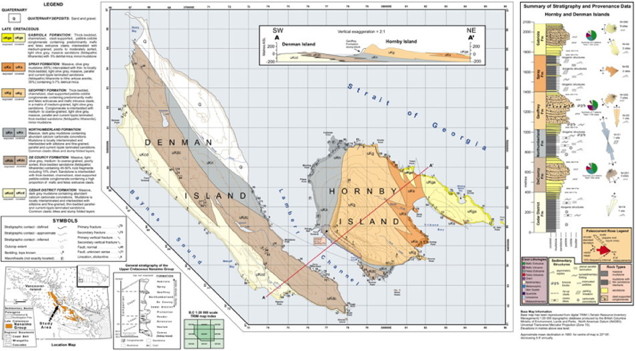Sandstone Basics
Sandstone is a category of rock made from sediment (a
sedimentary rock
). The sediment particles are clasts, or pieces, of minerals and fragments of rock, thus sandstone is a clastic sedimentary rock. It is composed mostly of
sand, which means particles of a medium size, so sandstone is a medium-grained clastic sedimentary rock. More precisely, sand is between 1/16 millimeter and 2 mm in size (silt is finer and gravel is coarser). Sandstone may include finer and coarser material and still be called sandstone, but if it includes more than 30 percent grains of gravel, cobble or boulder size it's classified instead as
conglomerate or
breccia (together these are called rudites).
Sandstone has two different kinds of material in it besides the sediment particles: matrix and cement. Matrix is the fine-grained stuff (silt and clay size) that was in the sediment along with the sand whereas cement is the mineral matter, introduced later, that binds the sediment into rock.
Sandstone with a lot of matrix is called poorly sorted. If matrix amounts to more than 10 percent of the rock, it is called a wacke ("wacky"). A well-sorted sandstone (little matrix) with little cement is called an arenite. Another way to look at it is that wacke is dirty and arenite is clean.
Minerals of Sandstone
Sandstone is formally defined strictly by particle size, but rocks made of carbonate minerals don't qualify as sandstone. Carbonate rocks are called limestone and given a whole separate classification, so sandstone really signifies a silicate-rich rock. (A medium-grained clastic carbonate rock, or "limestone sandstone," is called calcarenite.) This division makes sense because limestone is made in clean ocean water, whereas silicate rocks are made from sediment eroded off the continents.
Mature continental sediment consists of a handful of surface minerals, and sandstone therefore is usually almost all quartz. Other minerals—clays, hematite, ilmenite, feldspar, amphibole and mica— and small rock fragments (lithics) as well as organic carbon (bitumen) add color and character to the clastic fraction or the matrix. A sandstone with at least 25 percent feldspar is called arkose. A sandstone made of volcanic particles is called tuff.
The cement in sandstone is usually one of three materials: silica (chemically the same as quartz), calcium carbonate or iron oxide. These may infiltrate the matrix and bind it together, or they may fill the spaces where there is no matrix.
Depending on the mix of matrix and cement, sandstone may have a wide range of color from nearly white to nearly black, with gray, brown, red, pink and buff in between.
How Sandstone Forms
Sandstone forms where sand is laid down and buried. Usually this happens offshore from river deltas, but desert dunes and beaches can leave sandstone beds in the geologic record too. The famous red rock
s of the Grand Canyon, for instance, formed in a desert setting. Sandstone does not usually contain good fossils because the energetic environments where sand beds form don't favor their preservation.
When sand is deeply buried, the pressure of burial and slightly higher temperatures allow minerals to dissolve or deform and become mobile. The grains become more tightly knit together, and the sediments are squeezed into a smaller volume. This is the time when cementing material moves into the sediment, carried there by fluids charged with dissolved minerals. Oxidizing conditions lead to red colors from iron oxides, while reducing conditions lead to darker and grayer colors.
Geology of Hornby Island
The geology of Hornby Island originates entirely by depositional activity during the late Cretaceous period 99.6 – 65.5 million years ago and all the rock units belong to the Nanaimo Group which is characteristic of many of the Gulf Islands.
The shape of the island is believed to have been influenced over 55 to 42 million years ago as plate tectonic activities transformed the region. These plate movements pushed seabed sediments towards the mainland with massive pressure. The seismic activity that formed Hornby Island has left faults and fissures in the geology. These fractures act as water conducting highways that store water and can also move it quickly through and across the island’s aquifers.
The numerous cliffs, points, and bays can be attributed to past glacial activity and erosion processes. The Fraser glaciation event influenced the region between 11,000-13,000 years ago, long after the island was formed.
The sedimentary rocks of the Nanaimo Group which provide the foundation for Hornby Island are divided into four formations.
The Northumberland formation is a massive mudstone layer with thinner imbedded sandstone layers. This formation forms the entire northwest of Hornby.
The Geoffrey formation dominates most of the centre of the island and includes a massive conglomerate imbedded with medium-grained sandstone and mudstone layers.
The De Courcy formation occurs on the southern tip of the island. The De Courcy geology is similar to the Geoffrey formation with additional elements of marine sandstone and conglomerate.
The Spray formation occupies the lower areas around Tribune Bay and extends southward along the eastern side of the central ellipse of Hornby. The Spray formation is similar to the Northumberland and is comprised of alternating unit of mudstone and thin-bedded sandstone.

The Gabriola formation dominates Saint John’s Point and Helliwell Provincial Park. This formation is similar to the De Courcy and Geoffrey formations, but has thinner sandstone layers.
The geology of Hornby Island is of extreme importance in understanding issues of groundwater supply. Natural Resources Canada developed a waterscapes poster to graphically explain how to manage land use in ways that protect our water supply.
To log this earth cache.
Visit the site and Email the answers to the following questions to cache owner.
1. What factors do you think contributed to the formation of the caves on this beach.
2. Did you see any other interesting formations during your walk? If so briefly describe what you saw.
Optional
Upload a photo of you and/or the cave or a favorite sandstone formation you found.
| I am a proud |
 |